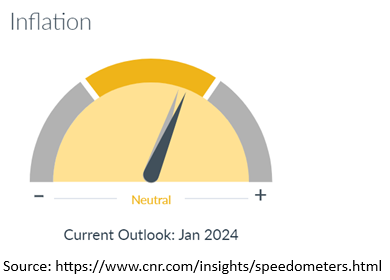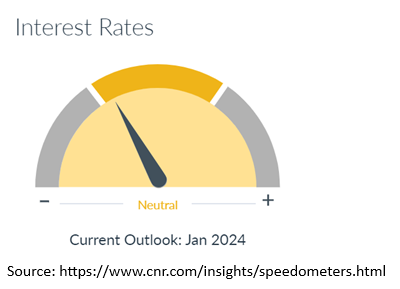The three topics listed above each play a pivotal role in the overall health and stability of our economy and have been hotly discussed over the past few years. With the start of 2024, we want to provide you with an update on these three economic indicators and highlight what you should expect moving forward.
Overview:
Inflation

Current Inflation Rate: 3.1% year over year
Next Inflation Release: January 11th, 2024 (tomorrow)
We have seen significant progress in the inflation rate over the last 18 months, from a trailing 12-month peak of 9.1% in June of 2022 to its current rate of 3.1%. This progress is part of what sparked the market rally of 2023, but the job is not yet finished as the Federal Reserve has a (arbitrary) target of 2% for inflation. Tomorrow’s CPI release for December will give us another data point, with the current expectation for inflation being 3.2%. While this would be a slight uptick, inflation does not necessarily move linearly since it is measured from the same month of the previous year. It is important to consider the movement of these data points directionally over a span of months.
We may still be off from hitting that 2% target, but we are encouraged by the drastic fall and continued downward momentum that we have seen in inflation. You can count on the federal reserve maintaining a restrictive interest rate until they are confident that the 2% target will be reached.
Labor Markets

Current Unemployment Rate: 3.7%
Next Unemployment Release: February 2nd, 2024
Labor markets have remained surprisingly strong in the face of rising interest rates, as unemployment has held between 3.4% -3.8% since the start of rate hikes in March of 2022. Higher interest rates create a restrictive economic environment which typically leads to an increase in unemployment. The fact that unemployment has remained so low through this period speaks volumes about the resilience of our economy. For some context, 3.4% is the lowest unemployment rate our country has seen in the last 54 years, so being able to hover around that number in the midst of restrictive rates has been a testament to the strength of our economy thus far.
While the labor market has held strong, rates are still at a restrictive level which will continue to put pressure on this part of the economy. Labor markets tend to be strong when there is optimism and growth on the horizon. Alternatively, when business trends are downturned or efficiencies are created through technology, businesses trim their labor expenses since it is usually one of the highest expenses on their profit and loss statement. We expect that by the end of this interest rate hiking cycle, the unemployment rate will see at least a slight uptick and may breach that 4% mark. As of now, economic data is not showing a downturn, but with company stances on work-from-home changing, we may see a softening of that number. We will be keeping a close eye on the labor market which will continue to be affected by the Federal Reserve’s approach to interest rates.
Interest Rates

Current Federal Funds Rate: 5.25-5.5%
Next Federal Reserve Meeting: January 31st, 2024
The raising of interest rates is the Federal Reserve’s main tool for combatting high levels of inflation. Over the last 2 years, the Federal Reserve has aggressively raised interest rates and has dampened the scorching hot inflation that we were seeing in 2021 and 2022 due to post-Covid supply constrains and excess dollars being injected into the economy. While great progress has been made, their final target of 2% inflation has not yet been reached. The balancing act for the Fed is to not act too early and overheat the economy again, but to also not act too late where a jumpstart is needed to reinvigorate the economy. So far, the soft landing has been more a reality than a fairy tale. However, the Fed still has to be very observant and not tip the scales.
The "Market" is showing a belief that interest rate cuts will be coming as soon as March 2024, with almost 70% estimating a reduction of the federal funds rate in that month’s meeting.
With a Federal Reserve that was slow to begin interest rate raises in 2022, and an inflation number that is still 1.1% over their target, it would not be surprising to see the Federal Funds rate remain at its current level for a larger part of 2024. This is something we will continue to monitor as we position portfolios and look to take advantage of the economic landscape.